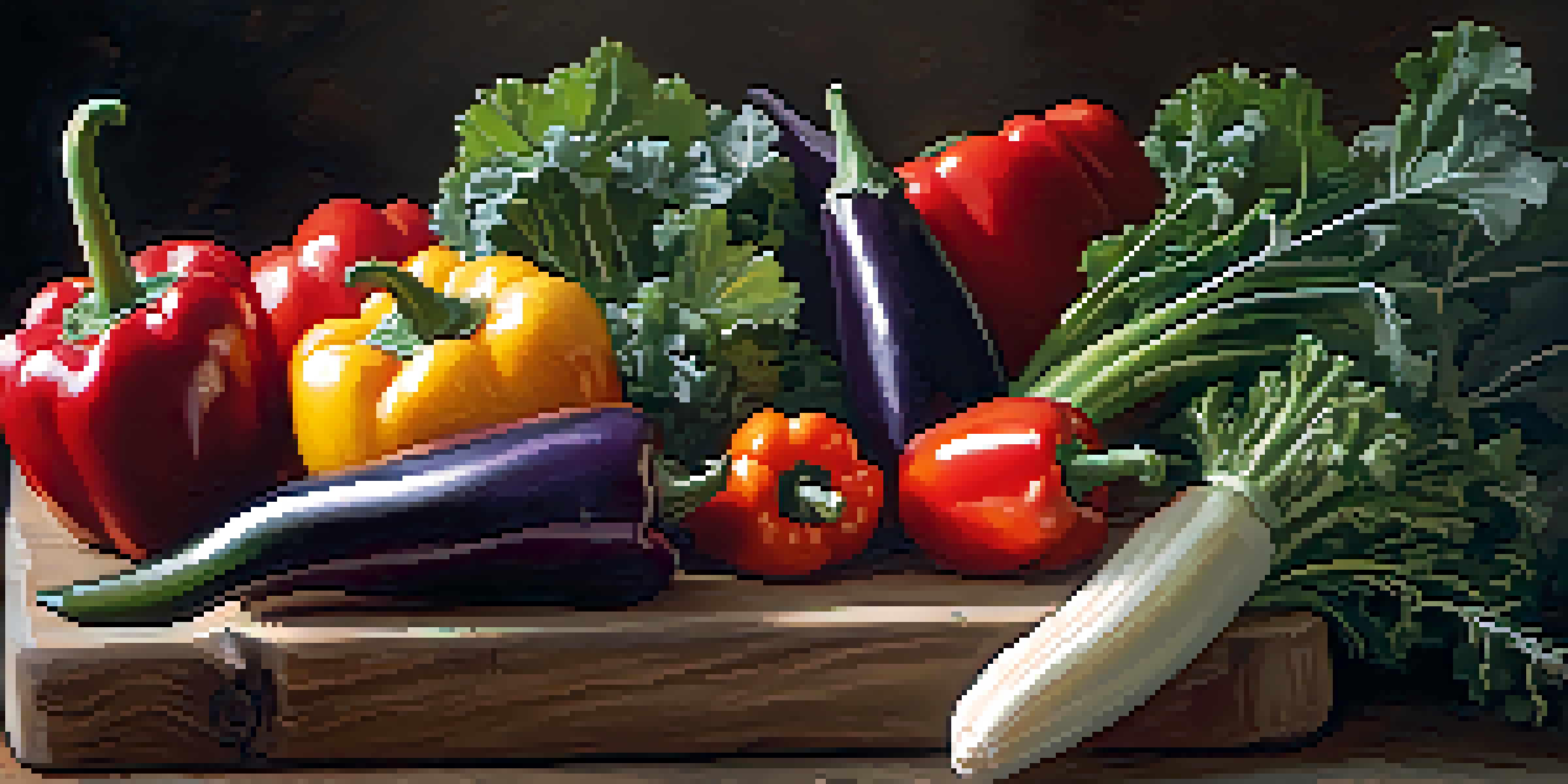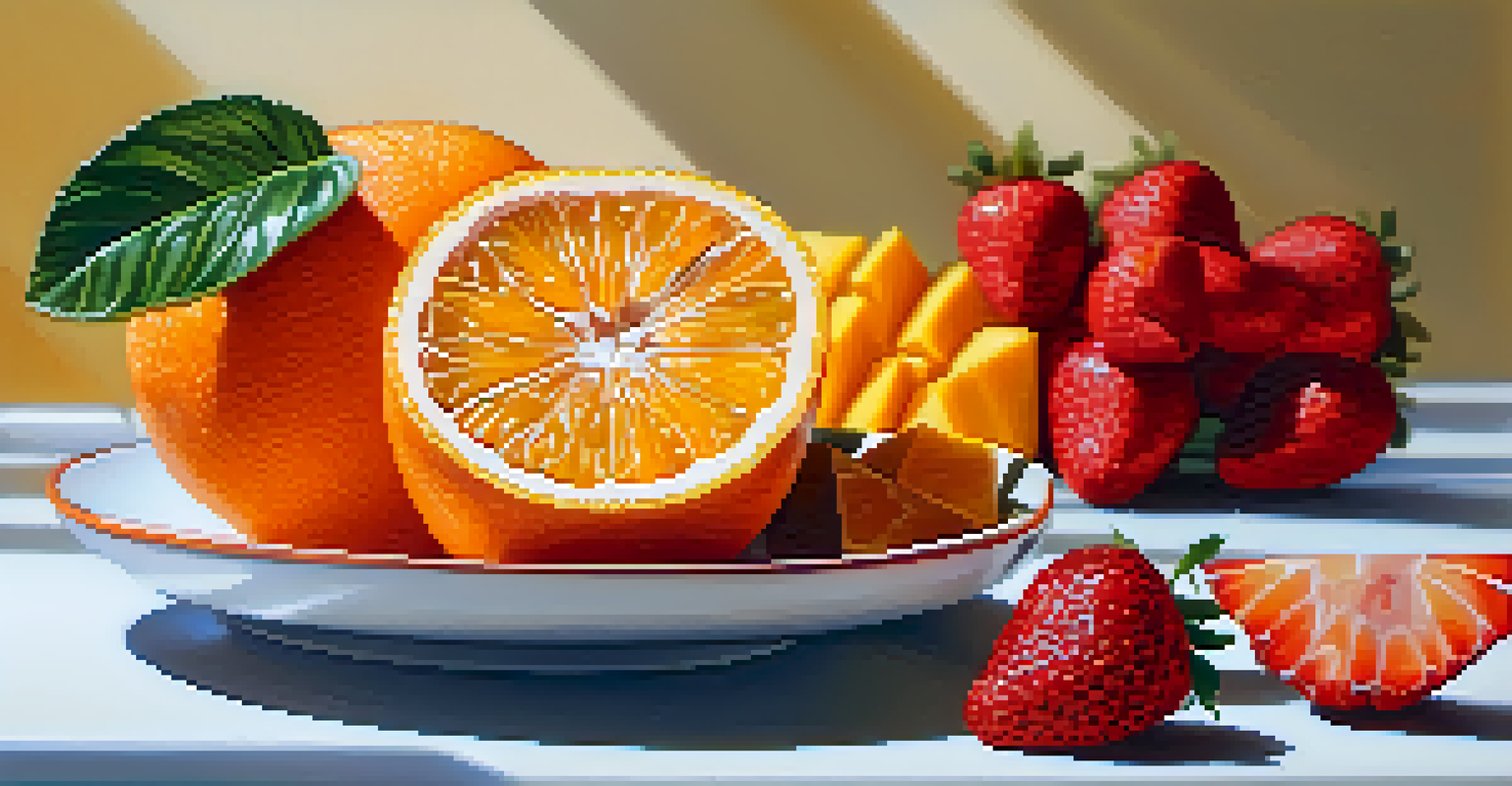Essential Vegan Ingredients for Captivating Food Photography

Colorful Vegetables: Nature's Palette for Stunning Shots
When it comes to food photography, colorful vegetables are like the brushstrokes of a masterpiece. Bright reds, vibrant greens, and deep purples create an eye-catching contrast that's hard to resist. Imagine a platter filled with roasted red peppers, kale, and purple eggplant; the colors playfully dance together, drawing viewers in.
Food photography is a way of capturing the beauty of food, making it irresistible and appealing to the viewer.
Incorporating a variety of textures is also essential. For instance, the crispness of bell peppers paired with soft avocados adds depth to your photos. It’s not just about the colors, but how they interact with each other, creating a visual feast that tells a story.
Don’t forget to think about seasonal vegetables. Using what's fresh and in season not only enhances the flavor of your dishes but also ensures your photos reflect the beauty of nature throughout the year.
Fruits: Juicy Details That Add Freshness and Appeal
Fruits are nature's candy, and their vibrant hues make them perfect for food photography. Think about the luscious reds of strawberries or the sunny yellows of mangoes—they instantly elevate any dish. A few strategically placed slices can add a pop of color and make your plate look more inviting.

Additionally, the glossy texture of fruits can create captivating reflections and highlights in your photographs. For example, a close-up shot of a juicy orange can make viewers almost taste its sweetness. This sensory appeal can significantly enhance the overall impact of your food images.
Colorful Ingredients Enhance Photos
Using vibrant vegetables and fruits adds eye-catching appeal and freshness to food photography.
Using fruits not only adds color but also conveys a sense of freshness. Whether you're showcasing a smoothie bowl topped with berries or a dessert drizzled with passion fruit, the inclusion of fruits brings a lively, appetizing quality to your photography.
Herbs and Spices: The Finishing Touch to Your Dishes
Herbs and spices are like the jewelry of food photography; they add that final touch that makes everything shine. A sprinkle of fresh basil or a dash of paprika can transform a simple dish into a visual delight. Their vibrant greens and reds bring life to your images, making them more appealing.
The colors of food play an integral role in how it is perceived and enjoyed, enhancing not just the taste but the overall experience.
The aromatic qualities of herbs can also evoke emotions and memories, adding to the storytelling aspect of your photography. For instance, a bunch of rosemary placed alongside roasted vegetables not only looks stunning but also hints at the flavors that await.
Experimenting with different herbs can also lead to unique compositions. Consider layering a variety of herbs in your shots to create depth and interest, making your food photos stand out on social media feeds or blogs.
Grains and Legumes: Textures That Tell a Story
Grains and legumes are the backbone of many vegan dishes, and their unique textures can add an intriguing element to your food photography. Think about the fluffy quinoa or the creamy texture of lentils—these components create a visual narrative that can entice viewers.
Incorporating a variety of grains, like farro, rice, or barley, can offer contrasting colors and shapes. A bowl of mixed grains topped with colorful veggies can create a stunning visual that speaks to health and nourishment.
Textures Create Visual Interest
Incorporating various textures from grains, nuts, and dairy alternatives helps convey depth and richness in your images.
Don't shy away from showcasing the preparation stages, either. A shot of grains simmering in a pot or being drizzled with dressing can add context and depth, inviting viewers to imagine the delicious meal that is about to unfold.
Nuts and Seeds: Crunchy Elements for Eye-Catching Images
Nuts and seeds are not only nutritious but also add crunch and visual appeal to food photography. A sprinkle of sunflower seeds or a handful of almonds can add both color and texture to your dishes. They create a contrast that draws the eye and makes the dish look more dynamic.
Additionally, the glossy surfaces of some nuts can reflect light beautifully in photos, creating interesting highlights. Imagine a close-up shot of a nut-topped dessert, where the glimmer catches the light—it’s hard to look away!
Incorporating nuts and seeds can also convey a sense of richness and indulgence. Whether it's a hearty salad topped with walnuts or a dessert adorned with pistachios, these ingredients can elevate your food photography to a whole new level.
Dairy Alternatives: Creamy Textures That Enhance Visuals
Dairy alternatives, such as cashew cream or coconut yogurt, can add luscious textures to your food photography. These ingredients not only provide a creamy finish but also enhance the visual appeal of your dishes. Imagine a smoothie bowl adorned with a thick layer of coconut yogurt—it’s creamy and inviting!
The versatility of dairy alternatives allows for creative presentations. For instance, drizzling cashew sauce over a vibrant veggie dish adds a beautiful contrast and highlights the freshness of the ingredients. This not only enhances the aesthetics but also hints at the delicious flavors waiting to be savored.
Stylish Presentation Matters
Thoughtful arrangement and natural lighting can elevate the visual impact of your dishes in food photography.
When photographing desserts, consider using dairy alternatives for a rich look. A slice of vegan cheesecake topped with a silky coconut cream can create a mouthwatering visual that tempts anyone scrolling through their feed.
Natural Sweeteners: Adding a Touch of Sweetness to Photos
Natural sweeteners like maple syrup, agave, or date syrup bring a glossy finish to your food photography. Their rich, amber tones can create a warm and inviting atmosphere in your images. A drizzle of maple syrup over a stack of pancakes is not just delicious; it’s also visually stunning.
These sweeteners can also add depth to your compositions. Consider capturing a dessert being drizzled with syrup; it creates a dynamic moment that can grab attention and evoke a sense of indulgence.

Additionally, using natural sweeteners can enhance the overall health message of your photography. Showcasing wholesome ingredients in their most appetizing forms can attract viewers who appreciate both taste and nutrition.
Presentation and Styling: The Art of Food Photography
Ultimately, how you present your vegan ingredients plays a crucial role in food photography. Styling your dishes with care can elevate their appeal dramatically. Think about using contrasting plates or rustic wooden boards to enhance the colors and textures of your ingredients.
Arranging your food in a way that guides the viewer's eye is also essential. Consider the balance and symmetry of your composition, allowing the vibrant ingredients to shine without overwhelming the viewer. A little thoughtfulness in presentation can go a long way.
Finally, don’t forget about lighting! Natural light can work wonders for your food photos, highlighting the textures and colors of your ingredients. Experiment with different angles and settings to find the most flattering light for your vegan masterpieces.